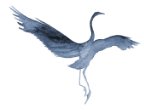A Pause For Beauty
One ought every day at least to hear a little song, read a good poem, see a fine picture,
and if it were possible, to speak a few reasonable words.
- Goethe
. . .
Below, the most recent Pause For Beauty post.
The Beauty In Imperfection
Beauty dislikes being captive to perfection.
That which is profound never lends itself to logical explanation: it involves endless mystery.
- Soetsu Yanagi, The Unknown Craftsman, A Japanese Insight Into Beauty
Unlike other collectors, most Tea masters prefer the incomplete; they look for slight scars or irregularities of form. If carried to excess, this desire will, of course, become unhealthy, but that there is a close relation between beauty and deformation cannot be denied. . .
Why should one reject the perfect in favor of the imperfect? The precise and perfect carries no overtones, admits of no freedom; the perfect is static and regulated, cold and hard. We in our own human imperfections are repelled by the perfect, since everything is apparent from the start and there is no suggestion of the infinite. Beauty must have room, must be associated with freedom. Freedom, indeed, is beauty. The love of the irregular is a sign of the basic quest for freedom.
The Buddhist aesthetician Shin’ichi Hisamatsu put forward a new idea. He says that the imperfect does not, in itself, constitute beauty. The imperfect is merely a negative concept. True beauty in the Tea ceremony must be more positive. It must go further, to the point of positively rejecting the perfect. . . . The shape of Raku Tea-bowls is deliberately deformed – by, for example, not using a wheel – and the surface is left rough. By such means the masters sought to give life back to beauty in the Tea ceremony.
- Soetsu Yanagi, The Unknown Craftsman, A Japanese Insight Into Beauty
A beauty that is not explicable is dearer than a beauty we can see the end of.
- Ralph Waldo Emerson, from “The Poet,” Essays, Second Series
An artist works with imperfection; if the starting point is perfection, there’s nowhere to go, nothing to create.
And as artists, we work with our own imperfection. Someone who has finished searching, has all the answers, has nothing to learn, cannot create art. Art is a search into realms where truth can be sensed but not seen. The big truths, the truths that are the territory of art, are contradictory.
Beauty in art encompasses freedom, including freedom from the perfect. Beauty in art encompasses the infinite, and the infinite by necessity encompasses freedom.
Items made by machines can be perfect. Items made by hand, including art, cannot be both perfect and have a soul. To give energy, to enlarge one’s concept of the potentials of life, a work of art must contain mistakes. Mistakes reflect where the artist was, what the artist’s state of mind was, at the moment of execution.
It is the things left out, deliberately or unintentionally, the things hidden, the things not fully executed or complete, that suggest, point to, life beyond the painting.
A work of art is the trace of a magnificent struggle. . . The mistakes left in a drawing are the record of the artist's struggle.
- Robert Henri, The Art Spirit
. . .
Do the mistakes, the unintended consequences, in your creative work offer a suggestion as to potential new directions?
And then there’s the difficult question:
Do the mistakes, the unintended consequences, in your life offer a suggestion as to potential new directions?
New Notecards:
Entire selection of notecards here.
Sign Up Here For The New Heron Dance E-Journal
Creativity As A Way Of Life
Latest Post
Current Month Pause For Beauty Posts
October Pause For Beauty Posts
Free shipping, no sales tax on all Heron Dance orders including original paintings, prints and posters.




